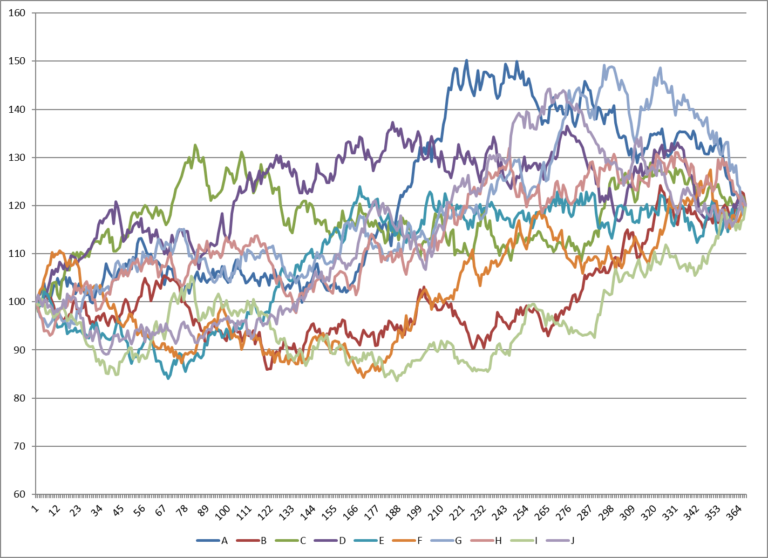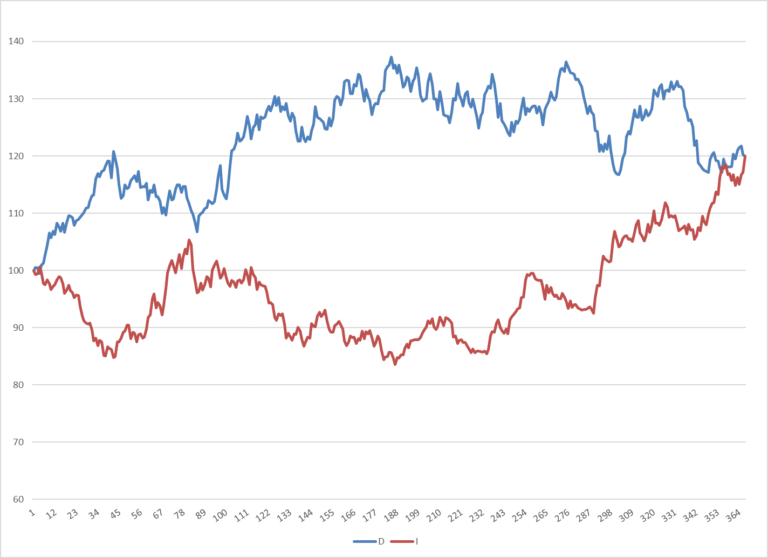We preach about diversification constantly at iNNOVA Wealth Partners, so we begin by apologizing for beating a dead horse if you have spoken to us before. However, the reason we are so adamant about it is because it’s one of the most powerful moves you can make when it comes to investing and today we’ll use some charts and graphs to show you the power of diversification.
Let us begin by simulating a years’ worth of daily returns for 10 different investment assets, cleverly named “A” through ”J”. We will simulate each asset to have an annualized volatility of 20% and return of 20% also. Here is the (admittedly hard to decipher) chart of our 10 asset universe:
As you can see each asset is very volatile (20% annualized volatility is roughly the same as emerging market stocks historically) and each asset returns 20% for the year. You might also notice that there are vastly different paths taken by each asset to their eventual 20% return. To highlight this, we will look at another chart that drills down on just two of the assets, “D” & “I”. Here it is:
Here we see just how different these assets behaved even though they have the same volatility and return. Asset “D” came out of the gate with incredible returns, never going below its starting value and even gaining as much as 35% before falling back down to earth over the last half of the period for its 20% gain. Conversely asset “I” starts in an immediate drawdown before recovering, only to fall again to a drawdown of over 20% before finishing the year strong and rallying all the way back to a 20% gain.
Why are we spending the time to go over this? Why might this be important to you? As we have mentioned in a few posts (Understanding Risk: It’s Not the Destination, It’s the Journey) your journey can be just as, if not more, important than the destination. If we presented someone with just the data, that each investment would have the same risk and the same return, and asked them to choose how they’d like to invest their hard earned savings they might assume how they proceeded wouldn’t matter. However, we would argue it matters tremendously. Let us use the above example to demonstrate why. First, most investors would have a very hard time sticking with an investment that lost 20% right at the start (which is exactly what asset “I” did). In addition to that, if we assume this person is using their capital to support a retirement lifestyle, this sudden drop will dramatically reduce the amount of withdraws they would safely be able to take in the future (Is Retirement a Palindrome). All of this would be left to luck if someone just chose an investment randomly.
So, as prudent investors, what should we do? While there are some sophisticated ways to allocate which are beyond the scope of this post what if we just diversified equally among the 10 different assets? It cannot be that simple, could it? Let us look and find out, here is the chart:
Here the bold black line shows the trajectory of investing equal amounts into each of the assets. It turns out combining all those individual volatile assets creates an incredible stable and consistent portfolio! Let us compare the data. Each of the individual assets has a volatility 20% while the diversified portfolio of assets has a volatility of just 6.17%, this is a reduction in risk by roughly 70%! We can also investigate the maximum drawdown of each asset compared to the portfolio to see how that improves.
|
A |
B | C | D | E | F | G | H | I | J | |
| Max DD | -20.6% | -18.5% | -18.3% | -15.0% | -17.7% | -23.8% | -20.9% | -14.1% | -20.7% |
-20.1% |
Those are some large moves down! The drawdowns for each asset range from worst -23.8% to best -14.1% for an average of -18.96%. However, when combining them into a portfolio the maximum drawdown was reduced to only -5.6% which is also a roughly 70% improvement over the average of the assets individually! This simple portfolio of equally weighting each asset instead of picking one to invest in has created a remarkable improvement, it is so simple everyone will do it and stick with it, right? It turns out the solution can be simple but that does not make it easy. If you look at the chart displaying all the assets together, you will notice that a good proportion of them are losing money through the first half of the period. Imagine checking your monthly statements during this time and seeing some of your investments doing exceptionally well while others are dragging your performance down. Imagine how well you would be doing if you just got rid of the laggards and invested in what is outperformed for the first six months. We see this behavior from time to time from even the most rational people. It is a seductive game and focusing on the winners can make you feel like you are missing out when you are really doing fine! However, let us say we throw in the towel and after six months we divest from the five worst performing assets and invest in only the top performing assets from that period. Here is how that would play out:
The switching strategy ends up costing roughly half of your return, not such a great outcome. Again, diversification can be simple, but it does not mean it is easy!
Hopefully, this quick illustration was a helpful way to show exactly how diversification can play a huge role in creating a sustainable investment strategy. From our example above, choosing one investment option provides a 20% return with 20% risk. But if you diversify your portfolio and choose all 10 investment options equally you would achieve the same 20% return, but with 70% less risk!
If you have any questions about your portfolio and if it’s diversified appropriately for you or if you’re having trouble sticking with the diversified portfolio you already own please don’t hesitate to reach out to us. We are always here for you!
Your Team at iNNOVA
iNNOVA Wealth Partners, LLC (“iNNOVA”) is a registered investment advisor. Information presented herein is for educational purposes only and does not intend to make an offer or solicitation for the sale or purchase of any specific securities, investments, or investment strategies. Investments involve risk and unless otherwise stated, are not guaranteed.
Readers of the information contained on these performance reports, should be aware that any action taken by the viewer/reader based on this information is taken at their own risk. This information does not address individual situations and should not be construed or viewed as any typed of individual or group recommendation. Be sure to first consult with a qualified financial adviser, tax professional, and/or legal counsel before implementing any securities, investments, or investment strategies discussed.
The tax information and estate planning information contained herein is general in nature, is provided for informational purposes only, and should not be construed as legal or tax advice. iNNOVA does not provide legal or tax advice. iNNOVA cannot guarantee that such information is accurate, complete, or timely. Laws of a particular state or laws that may be applicable to a particular situation may have an impact on the applicability, accuracy, or completeness of such information. Federal and state laws and regulations are complex and are subject to change. Changes in such laws and regulations may have a material impact on pre- and/or after-tax investment results. iNNOVA makes no warranties with regard to such information or results obtained by its use. iNNOVA disclaims any liability arising out of your use of, or any tax position taken in reliance on, such information. Always consult an attorney or tax professional regarding your specific legal or tax situation.



